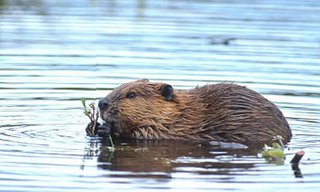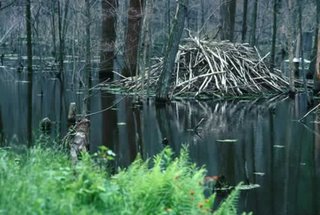The Return of the Beaver

Beavers (Castor Canadensis) are a relatively new sight along the Blue Ridge Parkway, even though they are no strangers to this region. There were an abundance of them until unregulated trapping caused their disappearance around 1897. Recently reestablished, beavers have become a topic of much debate.
Along the Blue Ridge Parkway, beavers sometimes clog culverts and spillways with debris; they undermine trails and create hazards. However, the ponds and wetlands they create provide essential habitat for fish, amphibians, reptiles, mammals and birds increasing the biological diversity of the region.
To their credit, the National Park Service welcomes the return of the beaver; they are after all, a native species. Populations are controlled only when activities endanger people or threaten to destroy major resources. Look for signs of beaver as you explore aquatic resources along the Parkway. See if you can determine any hazards created or habitats formed by the beaver, the largest of North American rodents.
Beavers are interesting creatures, they mate for life, but if one mate dies, the other one will find another companion. They mate when they are about three years old with the mating season being in January and March, in cold regions, and in late November or December in the south. Before birth, the female will make a soft bed in the lodge where, between April and June, she will have one litter of kits a year. The gestation period lasts about three months. At birth the babies eyes are open and they are able to swim within 24 hours of birth, and within a few days, will be exploring outside the lodge with their parents. Both the male and the female take care of their young which are weaned in about two weeks, but, will stay with their parents for two years.

They are territorial and will protect their lodges from other beavers by building piles of mud and marking it with scent.
A beaver can live to be 20 years old, and in adulthood, can measure four feet in length and weigh over 60 pounds. The beaver has webbed hind feet and a large flat, nearly hairless tail, which it uses to help maintain its balance when gnawing on trees. They will also slap their tail against the water to signal danger or to discourage predators. The beaver’s front legs are short with serious claws. Their rear legs are longer with webbed feet that help to propel them through the water as they swim. When under water, the beaver’s nose and ears close up and they have a special membrane that covers their eyes.
For the most part, the beaver's diet consists of tree bark and the cambium layer, the soft tissue which grows directly beneath the bark of a tree. They are particularly attracted to the bark of the alder, aspen, beech, birch, cottonwood, maple, poplar, and willow; they also eat other vegetation such as the roots and buds as well as water plants.
Their fur is generally dark brown on their back and sides and lighter brown on their chest and belly. The beaver waterproofs its thick fur by coating it with castoreum; an oily secretion from its scent glands. They have a thick layer of fat that helps keep them warm underwater. They have long sharp upper and lower incisors that grow throughout the beaver's life and are used for cutting into trees and other woody vegetation.
Controversy surrounding beavers is the result of the fact that they can have both a positive and a negative impact on the environment. When they build dams, they create new wetland environments for other species, wetlands that can also help slow erosion, raise the water table and help purify the water. Beavers can also play a major role in succession such as when they abandon their lodges and dams, aquatic plants take over the pond and eventually, shrubs and other plants will grow and in time, the pond becomes a meadow. In turn, the shrubs in the meadow will provide enough shade to allow tree seedlings to grow and, again, in turn, the meadow becomes a woodland.
On the other hand, dams can also cause problems by slowing the flow of water in streams causing silt to build up eliminating habitat for some species. Dams can also cause flooding in low lying areas.
However, with proper management, beavers can coexist with humans and in doing so enrich our environment with their presence. Remember, they were here before we were!
Images from: U. S. Fish and Wildlife Service
Technorati Tags: [Blue Ridge Parkway][Beavers][National Park Service][North America][rodents][environment]

1 Comments:
At Thursday, 23 March, 2006, Leslie Shelor said…
Leslie Shelor said…
There's a beaver pond on the Parkway not far north of Mabry's Mill. I've heard some comment against it. But it's wonderful to be able to see the beavers; they weren't in this area when I was younger.
Post a Comment
<< Home